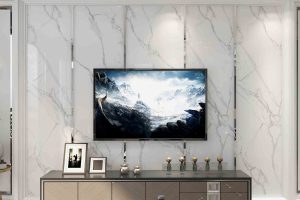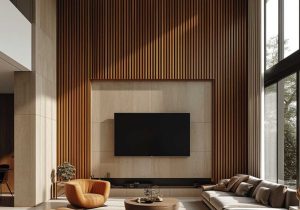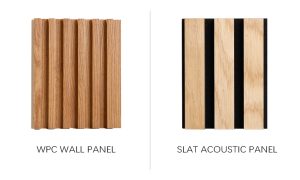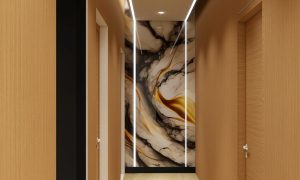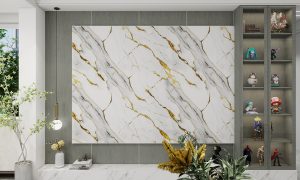Interior wall panels come in various types, each offering different aesthetic, functional, and material characteristics.
Here are some common types of interior wall panels:
1. Wood Panels

- Materials & Construction: Solid wood panels are crafted from natural hardwoods like oak, walnut, or pine. Wood veneer panels are made by bonding a thin layer of real wood to a substrate, such as MDF or plywood.
- Benefits: Wood panels add warmth, richness, and a natural aesthetic to interiors. They can be stained or painted and offer excellent insulation.
- Applications: Ideal for living rooms, bedrooms, offices, and spaces where a traditional or rustic look is desired.
- Aesthetic Appeal: Offers a timeless, elegant appearance with the ability to create various patterns like shiplap, beadboard, or raised panels.
2. WPC (Wood Plastic Composite) Panels
- Materials & Construction: A blend of wood fibers and thermoplastics, often extruded into panels that mimic natural wood grain.
- Benefits: Highly durable, resistant to moisture, insects, and rot. Low maintenance and eco-friendly as they are often made from recycled materials.
- Applications: Commonly used in both residential and commercial settings, especially in areas prone to moisture, like basements or bathrooms.
- Aesthetic Appeal: Offers the look of wood with enhanced durability, available in various colors and textures.
3. PVC Panels

- Materials & Construction: Made from polyvinyl chloride (PVC), these panels are lightweight, waterproof, and easy to install with tongue-and-groove systems.
- Benefits: Water-resistant, making them ideal for wet areas. They are also easy to clean, fire-resistant, and offer good thermal insulation.
- Applications: Perfect for bathrooms, kitchens, utility rooms, and commercial spaces like clinics or schools.
- Aesthetic Appeal: Available in various finishes, including smooth, textured, or printed designs that can mimic tiles, marble, or wood.
4. MDF (Medium-Density Fiberboard) Panels
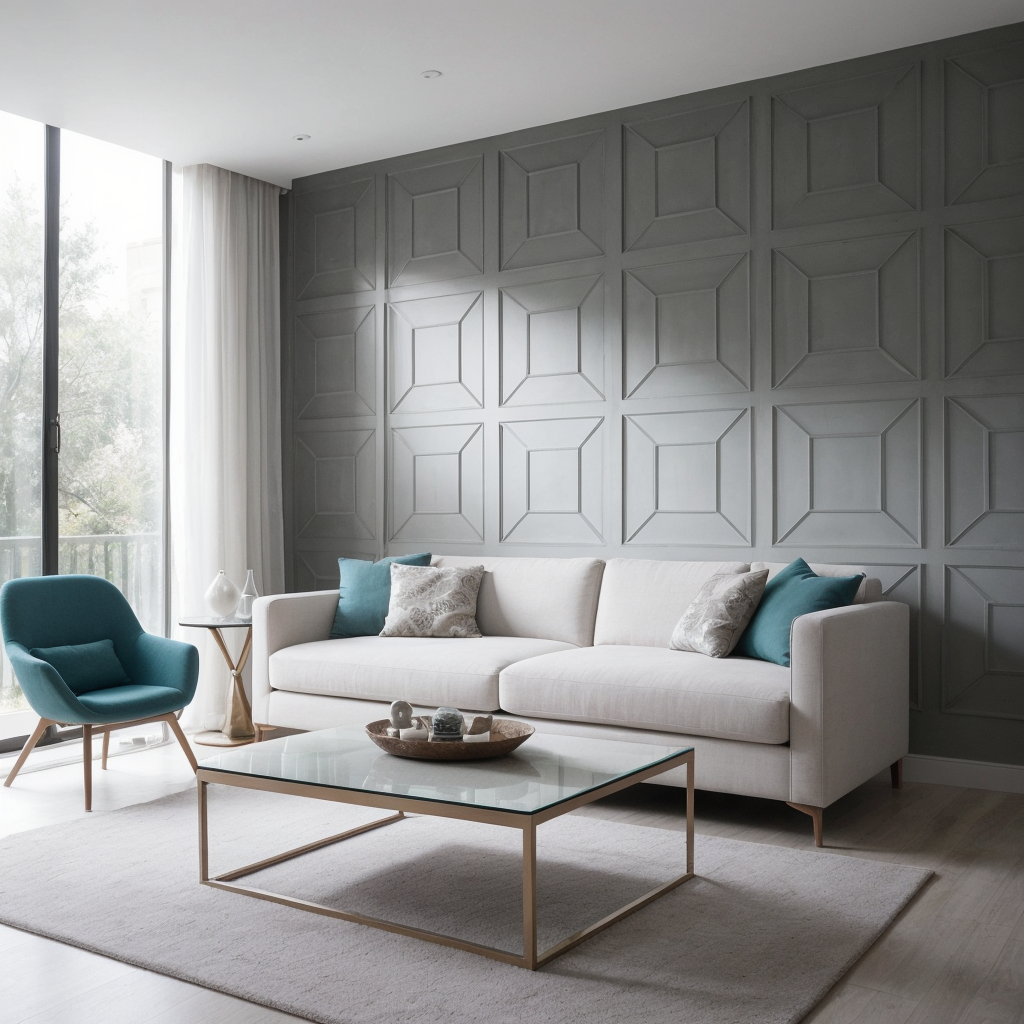
- Materials & Construction: Made from compressed wood fibers, MDF panels are smooth and uniform, ideal for painting or veneering.
- Benefits: Cost-effective and versatile, MDF panels can be molded into intricate designs, making them popular for wainscoting or decorative trims.
- Applications: Commonly used in interior spaces like living rooms, dining rooms, and hallways. They can be used for full wall coverage or as accent panels.
- Aesthetic Appeal: Provides a clean, modern look, with the ability to be customized in any color or pattern.
5. Gypsum (Drywall) Panels
- Materials & Construction: Gypsum is a soft sulfate mineral used to create drywall or plasterboard panels. These are typically covered with paper and can be finished with paint or wallpaper.
- Benefits: Inexpensive, easy to install, and versatile for various wall treatments. Gypsum panels also offer some level of fire resistance and soundproofing.
- Applications: Used universally in residential and commercial construction for walls and ceilings.
- Aesthetic Appeal: Provides a smooth, flat surface that can be painted or finished with textures, wallpaper, or tiles.
6. Metal Panels
- Materials & Construction: Often made from aluminum, steel, or tin, metal panels can be plain, embossed, or perforated for decorative purposes.
- Benefits: Highly durable, fire-resistant, and easy to clean. They also offer a modern, industrial aesthetic.
- Applications: Ideal for commercial spaces, kitchens, bathrooms, or as accent walls in contemporary homes.
- Aesthetic Appeal: Provides a sleek, modern look with the possibility of various finishes like brushed, polished, or painted metal.
7. Fabric Panels
- Materials & Construction: Fabric-covered panels are typically made with a core material like foam or fiberglass, covered in textile for texture and acoustic benefits.
- Benefits: Softens the look and feel of a room while providing sound absorption. They can also be used to add color, pattern, and texture.
- Applications: Common in theaters, recording studios, offices, and homes where soundproofing is desired.
- Aesthetic Appeal: Offers a cozy, inviting appearance with endless customization options in terms of fabric, color, and design.
8. Glass Panels
- Materials & Construction: Glass panels are made from tempered or laminated glass and can be clear, frosted, etched, or colored.
- Benefits: Provides a sleek, modern appearance and allows for light to pass through, which can make spaces feel larger and more open.
- Applications: Used in modern homes, offices, and commercial spaces for partitions, accent walls, or shower enclosures.
- Aesthetic Appeal: Adds a contemporary, minimalist look with the ability to be customized with different finishes or embedded designs.
9. Stone Panels
- Materials & Construction: Can be made from natural stone like marble, granite, slate, or engineered stone. Stone veneer panels are a lighter alternative made by bonding a thin layer of stone to a backing material.
- Benefits: Highly durable, luxurious, and adds significant value to a property. Natural stone panels also provide excellent insulation and are fire-resistant.
- Applications: Used in high-end residential and commercial spaces, often as feature walls, fireplaces, or bathroom surrounds.
- Aesthetic Appeal: Offers a luxurious, timeless look with a variety of textures and colors that only natural stone can provide.
10. PVC Marble Sheets

- Materials & Construction: Made from PVC and designed to mimic the look of real marble, these sheets are lightweight and more affordable than natural marble.
- Benefits: Water-resistant, easy to install, and maintain. They provide the luxurious look of marble without the weight and cost associated with real stone.
- Applications: Popular in bathrooms, kitchens, and commercial spaces where a high-end look is desired at a lower cost.
- Aesthetic Appeal: Provides the elegant appearance of marble in various colors and patterns, suitable for modern or classical interiors.
11. 3D Panels
- Materials & Construction: Made from materials like PVC, gypsum, MDF, or even eco-friendly options like sugarcane fiber. These panels create a three-dimensional effect on the wall.
- Benefits: Adds texture and depth to a space, turning walls into statement pieces. They can also help with soundproofing.
- Applications: Used in living rooms, bedrooms, offices, or as feature walls in any interior space where visual interest is desired.
- Aesthetic Appeal: Offers a modern, artistic look with the potential for endless design possibilities, from geometric patterns to organic shapes.
12. Brick and Stone Veneer Panels
- Materials & Construction: Thin slices of real or faux brick or stone are adhered to a backing material like plywood, offering the appearance of a solid brick or stone wall without the weight.
- Benefits: Lightweight, easier to install than full brick or stone, and cost-effective. They provide the rugged look of brick or stone without the need for structural reinforcement.
- Applications: Ideal for creating accent walls, fireplaces, or adding a rustic touch to interiors like lofts, kitchens, or basements.
- Aesthetic Appeal: Delivers a rustic, industrial, or traditional look, perfect for creating a cozy, warm atmosphere.
Summarize
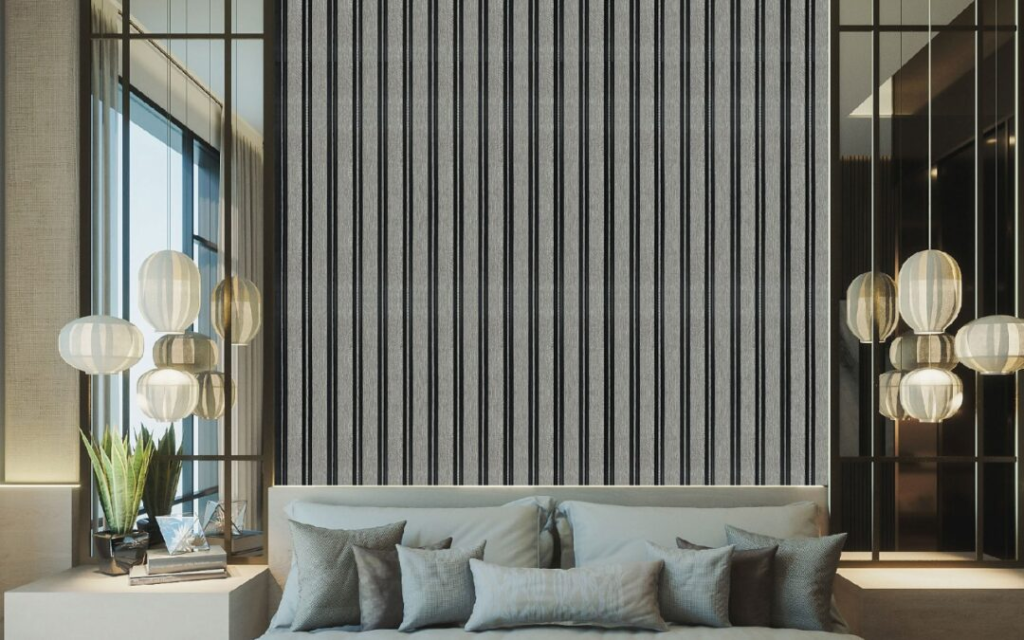
There are many different siding design styles you can try. Each style will bring you a different experience. But be aware that most wood is not only expensive to replace, but also requires regular maintenance. Before making a decision, it’s best to discuss it with your family and look for siding materials that are strong, durable, and low-maintenance.
COMPASS can provide you with a variety of different wall panel decoration materials. Whether it’s WPC wall panels, acoustic panels and 3D wall panels with a solid wood look, or UV marble slabs with a stone look. pu stone wall panels, contact us at any time and you can get the wall panel materials you want.


